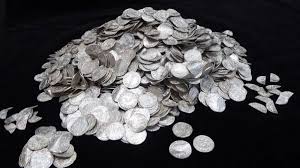‘Unprecedented’ Norman coin hoard bought by UK trust for over €5 million

A remarkable collection of 2,584 silver pennies dating back to the Norman Conquest has been acquired for £4.3 million (around €5.16 million), setting a record as the most valuable treasure ever discovered in the UK.
The South West Heritage Trust secured this “unprecedented” hoard from the Crown, with the metal detectorists who discovered the coins sharing the proceeds with the landowner.
Known as the Chew Valley Hoard, the treasure was unearthed on 26 January 2019 by seven friends during a metal detecting outing in the Chew Valley, set in Bath and North East Somerset.
“The hoard symbolises a pivotal moment in English history, and we are delighted to have made this acquisition so that it may be enjoyed by generations to come,” Sam Astill, the South West Heritage Trust’s chief executive, said.
Lisa Grace and Adam Staples, who – together with five friends – found the majority of the coins on that momentous weekend trip to the Chew Valley, have said before how it felt like a “dream” to uncover such a significant treasure.
In the UK, finders of potential treasure are legally required to inform their local coroner under the Treasure Act 1996. This act provides several definitions of treasure, including: prehistoric items, coins made of gold or silver that are at least 300 years old, and more recent valuable objects that have been intentionally hidden.
If the find is declared treasure, the discoverer can’t simply sell to the highest bidder or keep their find as a unique piece of home decor – they must offer it for sale to a museum at a price determined by the British Museum’s Treasure Valuation Committee.
Coins from the hoard will go on display at the British Museum from 26 November, before touring museums in the UK including Bath and finding a permanent home at the Museum of Somerset.
Experts believe the coins were buried for safekeeping amidst the chaos of the Norman Conquest. Nearly half of the coins feature Harold II, the last crowned Saxon king of England (reigned 1066), while the other half depict William I (reigned 1066-1087). Just one coin features Edward ‘The Confessor’.





